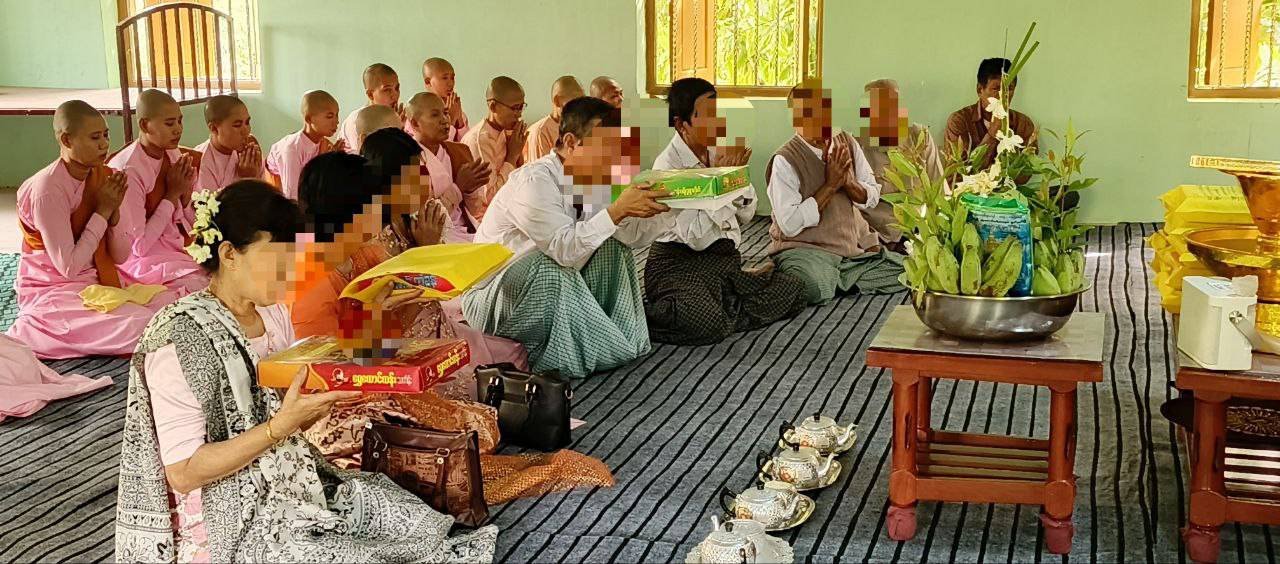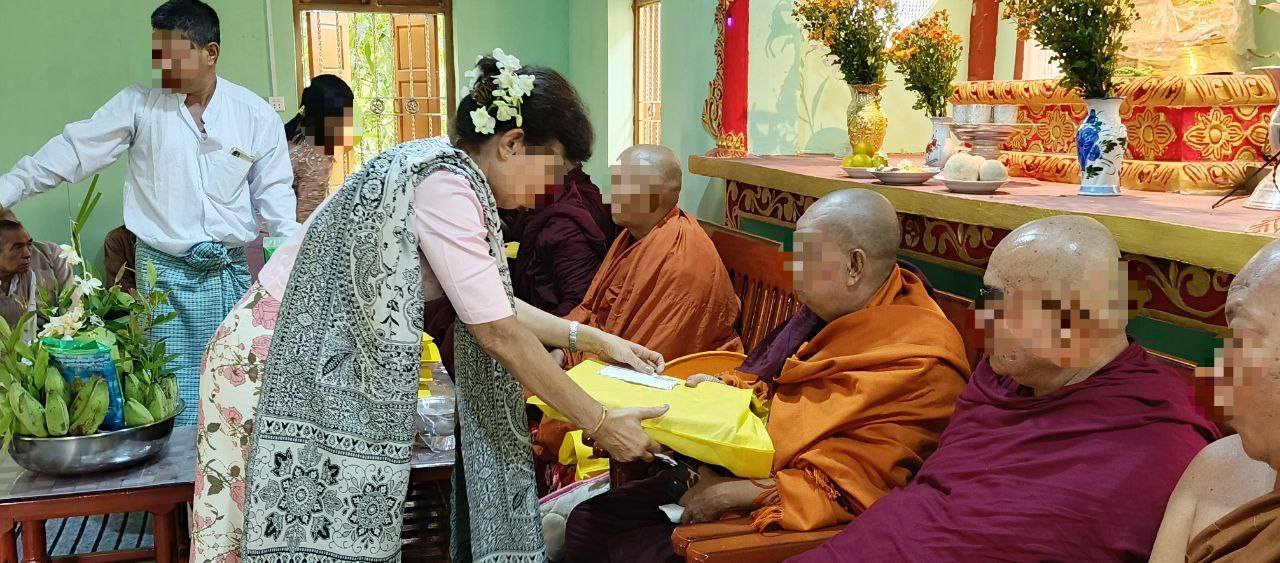Sky-drop Kathina: "The Largest Alms-Giving Ceremony of the Buddhist Year!"
In a recent essay, our team leader shared about the challenges being faced by Myanmar’s Buddhist community as they attempt to celebrate the Kathina festival under military rule, where traditional ceremonies like Thadingyut and Pavāranā have been disrupted by fear and the targeting of monks by authorities. With many monks facing forced disrobing, arrests, and even conscription, local laypeople are often unable to openly participate, making international support essential. Initiatives like the “Sky-Drop Kathina” aim to sustain the monastic community by delivering donations to remote areas. Despite the oppressive environment, these efforts reflect resilience in preserving Myanmar’s spiritual traditions.
He provides a further update here, which we share to those meditators and practitioners who might be keen to support his important effort. In the following essay, he notes that as the country remains engulfed in conflict, the serenity of this traditional festival has been all but shattered. Monastic communities, usually havens of peace, have instead become sites of violence, displacement, and loss. Reports of military raids on monasteries, the killing and displacement of monks and civilians, and the destruction of sacred sites underscore the profound impact of the ongoing conflict on Myanmar’s Buddhist institutions. Yet amid this landscape of smoke, ruin, and resilience, the monastic communities strive to uphold their traditions and find moments of solace and solidarity during the Kathina Festival, even as their world is cast into turmoil.
“While the country remains shrouded in turmoil and the injustice of a junta fueled by anger, greed, ignorance, and illusion, and many monks have been unable to undertake or complete their Vassa retreat due to armed conflict, we still aim to help other monks gain some relief from their monastic codes, praying for all people in the country to be free from oppression and for universal freedom, justice, peace, and unity to thrive.”
What is happening with the monastic communities in Myanmar during the Buddhist Kathina Festival?
Before addressing this question, it’s important to acknowledge the tragic news reported by Myanmar Now on October 28 about a monk aiding displaced families in Pauk Township, Magway Region. The report stated that a junta force of around 100 troops, including pro-junta militias (known as Pyu Saw Htees – Pyithusit), raided an IDP camp near Deedote Kwin Village, located 13 miles south of the town, at around 5.00 am on October 28, capturing the camp’s leader monk along with 18 others, and also killing two villagers in their 60s. They burned ten huts, including one that served as a clinic for the camp, and seized two trucks, one of which was loaded with sacks of rice. A subsequent report stated that insurgent forces attacked the junta troops during their return, resulting in ten deaths, as confirmed by an officer from the insurgent group. In a drone investigation, they reported discovering three bodies at the junta troops’ camp and speculated that these might belong to the monk and a clinic staff member based on their clothing.
To share now about the holiday in question, as I wrote about in my last essay, Kathina is a festival celebrated from October to November, marking the conclusion of Vassa, the monastic monsoon retreat. Since the time of Buddha, monks have remained in one location during the monsoon retreat, and the Kathina celebration marks the time for them to move on. The festival celebrates the offerings of cloth given to a specific community of monks by lay supporters, as the monks collaboratively create a robe and give it to the neediest or eldest member with their collective consent. Among the key aspects of this event, monks cannot request or hint to anyone, even their mothers, to offer the robe, as the sponsor must offer it as common property of the Sangha–the monastic community–before all members transform it into individual property by sharing it with a member based on their collective consent. With reverence for these unique aspects of the festival, lay followers offer one or more robes to the monastic communities–monasteries–during this period from the full moon day in October to that in November. For these reasons, the BBC has referred to it as “the largest alms-giving ceremony of the Buddhist year!” This year, the first full moon day of the festival falls on October 17, while the second is on November 15.
However, during this sacred festival, monks in Myanmar are unable to celebrate peacefully, as some have been killed, including the monk who led the IDP camp in Pauk, while others fled their monasteries. A news report from October 29 stated that airstrikes and artillery bombardments by the junta’s forces resulted in the deaths of 12 people, including monks, at the Waw Su Village IDP camp in Madaya township near Mandalay. The photos show local IDPs residing in the monasteries that have opened their doors to them as camps. On October 30, a post from the local news outlet Khit Thit Media reported on the situation with photos, some of which depict the extensive damage to monastic buildings near a pagoda that were burned down to ash by the junta’s forces and pro-junta militias in Kyi Su Village and Kyauk Taing Village in Kantbalu Township, Sagaing Region. The news reported that the junta’s troops raided an IDP camp established in the monastery of Eai-paung Village, taking 34 men and 3 women who were sheltering there to their military base No. 6006 in the town. In the afternoon, they conducted a raid on Kyi Su Village and Kyauk Taing Village, setting fire to 2 monastic buildings in the former and 1 in the latter, reducing them to ash, along with 700 houses and 1 school building from both villages. It was reported that the two villages were previously raided two years ago, when the houses were reduced to ash, but the residents returned and rebuilt; now, the monasteries have been destroyed in this latest incident.
Not only were the monks in jeopardy because of the junta’s atrocities, but the nuns were also at risk. A news report described the junta’s airstrikes on a nunnery near Alpha Cement Factory in Patheingyi Township on October 22. A 60-year-old local confirmed that it was Wai Pon La (Vepunla) Nunnery located along the route to the factory in Aung Tha Pyay Village, stating, “The first plane bombed the nunnery and also fired machine guns, shooting four times. And, then it flew south and opened fire on Pha Yaung Taung (Gold Mine).” Fortunately, the nuns escaped from the nunnery when fighting broke out in the surrounding area three months ago. The local man mentioned that a few remained to guard the place, and no members of the insurgent forces were residing there. No further news reports have been found yet regarding those who stayed at the nunnery.
Another local news outlet published a report on October 30 about three injured IDP monks in Chauk township, Magway Region. [Chauk is a township neighboring Bagan.] Like in other areas, the junta’s forces raided Naywae Taw Village and Ywarma Village on October 27, burning down 35 houses, the monasteries from both villages, and the ambulance belonging to a local healthcare charity. Due to the bombings and airstrikes by the junta’s forces, displaced villagers and monks from other villages who were sheltering at the monastery included a man and a woman in their 70s, a sick elderly disabled man, two monks in their 50s and a young monk over 20a years old.
Also tragically, a recent news report confirmed the extensive damage to the monasteries in Kantbalu township during this holy Kathina season. The local man said that the North Monastery was a meditation center before the coup and all the buildings in the monastery were reduced to ash, except from a dining house. In the south monastery, the dining house and Dharma Hall were set on fire. Due to junta troops' bombings using drones, Pagodas were also damaged.
In summary, it is clear that many monks across Myanmar simply cannot experience the Kathina season in peace and safety! At the same time, reports indicate that most monastic communities in conflict zones, such as the Sagaing Region, Magway Region, Mandalay Region, and certain areas in northern and southern Shan State, are either conducting their Kathina events superficially due to safety concerns–uncertain if junta forces have raided their monasteries–or organizing “Sky-drop Kathina” events under the guidance of some monks, as most monasteries have not received invitations or pledges from lay sponsors for a Kathina robe.
Our local team plans to assist these monastic communities with Sky-drop Kathina robes, which have been earmarked as donations from those who would like to support this, so that the monks can gain five privileges, allowing them to be temporarily free from certain monastic disciplines for five months, starting from the first day after the end of the Vassa until the full moon day in February (February 12th, 2025). Since every Bhikkhu (monk) looks forward to these privileges during this five-month period of the Buddhist year, we, as lay devotees, wish to support them and traditionally celebrate the festival by offering Kathina robes.
While the country remains shrouded in turmoil and the injustice of a junta fueled by anger, greed, ignorance, and illusion, and many monks have been unable to undertake or complete their Vassa retreat due to armed conflict, we still aim to help other monks gain some relief from their monastic codes, praying for all people in the country to be free from oppression and for universal freedom, justice, peace, and unity to thrive.
Your support for this special Kahtina event for these vulnerable monastics is greatly appreciated!





